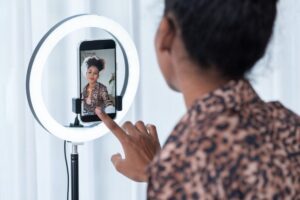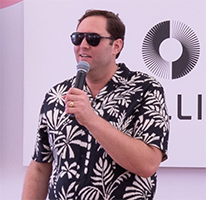
The coffee category is a competitive one—but it’s also packed with potential for brand loyalty.
According to Peet’s Coffee brand research, 76 percent of consumers can tell the difference between a good and a bad cup of coffee. Plus, many are looking for a brand to defend high-quality coffee, craft and culture.
In this, Peet’s saw an opportunity. While other folks in the coffee category were creating dessert-like drinks and outlandish flavors, it sought to win over this discerning bunch by keeping is simple. Enter its new brand platform and first-ever 360 marketing campaign, “Coffee for Coffee People.” The 12-week initiative includes a series of spots taking aim at the coffee industry’s propensity for complicated drink orders, as well as a cheeky “Disloyalty Program” on National Coffee Day that honors competitors’ loyalty points as currency for a cup of Peet’s.
“As a small player in a very large and loud category with these mega brands, we knew if we just came out and told our story, which was ultimately a very simple one about quality, that we wouldn’t break through the clutter,” said Peet’s Coffee VP of Brand Jessica Buttimer. “So we decided to focus on what we aren’t in the beginning, and push off of these outlandish trends.”
Here’s our chat with Buttimer about the campaign’s strategy, core objectives, distribution channels, technical feats and challenges, as well as the brand’s ideas for next year.
Chief Marketer: What was the impetus behind launching the campaign?

Jessica Buttimer, VP of Brand at Peet’s Coffe: We did about six months of research with coffee consumers. The brand’s been around for a long time—57 years—and we’ve been a quiet, humble brand, where word of mouth, our cafés and the quality of our product created our reputation. But we haven’t really told our story broadly.
A lot of the folks in the industry had lost the plot, as we like to say. They were offering these outlandish flavors, complex dessert-like drinks, tech gimmicks—and they pushed coffee to the background. That was very different from our belief system and what we felt was important in the category. We were hearing that consumers were actually craving the same thing that we were, which was someone who would defend coffee quality, the craft, the culture.
The campaign is framed the way it is because as a small player in a very large and loud category with these mega brands, we knew if we just came out and told our story, which was ultimately about quality and a very simple one, that we wouldn’t break through the clutter. So we decided to focus on what we aren’t in the beginning and push off of these outlandish trends that we were seeing. We thought that we would get more attention that way.
CM: What are your strategic marketing goals with this? What are the KPIs?
JB: Our goal is to be a strong number two premium brand in the category. You can probably guess who number one is. It’s Starbucks. We admire a lot of the things that Starbucks does, but we think we are for a different consumer and have a different approach. The way we’ll measure that is, in the beginning we’re looking for familiarity growth. Not just awareness. We’re actually pretty strong on awareness, but when you get down to it, people don’t really understand who we are and what we do that’s different from the big guys. So, telling that story and building familiarity feels like a better way to measure than just pure awareness or impressions. That’s our key metric.
We are also getting amazing early results on traffic and orders on our website, and we expect to see retail traffic pick up as a result of “Disloyalty” this week. We’re looking for it to be a full funnel approach, where it all starts with familiarity, getting that story out there. But then we are also looking at the traffic and the orders side of things, and giving ourselves some time for that to build.
CM: What are some other highlights from your consumer research?
JB: Seventy-six percent of those consumers feel like they’re discerning and can tell the difference between a good and a bad cup of coffee. Another one was that consumers identify with their coffee brand. I spent 15 years in packaged goods and did mainly cleaning products and more functionally-driven categories. And then I moved into footwear and technology. The reason why I’m giving this background: there I learned this importance of identifying with your brand. Obviously in footwear, it’s super important.
I got intrigued—to come back out of retirement, actually—to work on coffee because it’s one of the few packaged goods products where people do identify with the brand. Part of that is the café side of the business: you carry the cup around with you. It’s this very complex category where the quality of the product you’re using says something about you. A pretty high percentage of this audience feels like they identify with their coffee brand and that it significantly tells you something about who they are.
CM: What does your target market look like? Are you looking to appeal to a specific generation?
JB: The passionate coffee enthusiast is much more diverse than our current user group in a couple ways. They are younger than the current Peet’s consumer. They’re all ages, but they average in the millennial group and a little bit of Gen X, and there’s certainly Gen Z and baby boomers as well. The Peet’s consumer is older than that group, so we’re “younging-up” the brand. We’ve got three core objectives. The first is to tell our story. The second is to young-up the brand, and the third is to modernize our assortment and our experience. That’s more on the product and the retail side of things.
The other demographic diversity is geography. Our brand is concentrated in the West Coast. We tend to be an urban brand. We have distribution nationally in grocery stores, but most of our cafes are on the West Coast. And then we’ve got pockets in D.C., Boston and Chicago. But because we have a national CPG presence, it’s important that we have a national campaign and familiarity. We have a big opportunity in the center of the country and the East Coast cities.
CM: How is the campaign being distributed? Are you experimenting with other channels in addition to video?
JB: We’ve got six spots with various cutdowns, and those are going on connected TV, OTT. We’ve got Hulu, YouTube… Then we’ve got Spotify for audio. That’s a channel that is underutilized by the category, so that was a good place for us to invest. It gets you into different dayparts and different occasions. Another part is out-of-home, which is also underutilized in the category. And when you have a café business, it just makes a lot of sense to hit people near the cafés geographically. The last piece is social, where we have been pleasantly surprised with the level of engagement that we’re seeing on Instagram, and in particular, TikTok. It’s hard to get people to comment on ads, and we’re seeing a lot of positive sentiment on TikTok as well as Instagram.
CM: Let’s talk about your “Disloyalty Program.” Why did you decide to go that route and deliberately target competitors’ loyalty programs?
JB: It’s breaking through the clutter, but it’s also this willingness to challenge norms. We’re an underdog brand. Even though we are sometimes perceived as a chain, there’s very few things about us that are like a chain. We take a more local approach to things, and scaling our smallness is one of our cross-functional strategies. So we wanted to highlight our non-corporate approach and our willingness to challenge the way the broader category works, and couldn’t think of a better way to get people to try Peet’s than to say, “Hey, it’s not just free, it’s actually using your points.” And by the way, those points don’t actually transfer so they can still use the points elsewhere.
CM: I assume you’re not working with Starbucks on this.
JB: Yeah, no. We legally couldn’t have done that. But that’s the brilliance of it. We could have just gone out and said, “Have a free drink on us,” but we wanted to do it in a more buzzy and competitive way.
CM: Were there any challenges to the program legally? Or in putting it together?
JB: We thought legal would be a big challenge. At the end of the day, our whole company likes to do things differently, and they were very open-minded to it. We had to be creative in the way we worded it and depicted it. But legal ended up not actually being a challenge. The bigger challenge was technology. We have an app, we’ve got an IT team that knows how to do things like this, but this was probably the most complex technology-driven promotion that we’ve ever done. There was quite an investment in making it easy for the consumer. We didn’t want people standing in line trying to upload something and having it fail, so we did a lot of QA work to make sure it was seamless for the consumer.
The other challenge: We’ll find out on [National Coffee Day] what traffic looks like in our stores. We value our baristas and we don’t want to put them under any undue stress. They want traffic just as much as we do. But they also want to give a really good customer experience and not have people waiting in line for a long time.
CM: What are your plans for growth beyond this campaign?
JB: This is a 12-week campaign in just four markets—San Francisco, LA, D.C. and Boston. We did that intentionally because we wanted to get our foot in the door and learn what it did. The plan from here would be to expand to more markets to keep telling the story, but keep it fresh. You’ll see us continuing to challenge norms in the category, but we’ll do it differently next year.
CM: What’s up next for the brand?
JB: Getting the experience right. We will make sure that the consumer experience is top notch before we start opening more stores, for example, or getting much bigger than we are today in terms of our footprint. The biggest opportunity is to continue to tell our story and to find those people that share our values, and to become a bigger brand as a result of that familiarity—not necessarily trying to be on every street corner.
You will see us differentiating. There’s some places in our menu where it’s hard to tell how a Peet’s drink is different than maybe a Starbucks drink. And you’re going to see us more clearly differentiating on flavors, and on the kinds of products we sell. We want to make sure we’re being true to the strategy of being “coffee for coffee people.” You’ll see some changes to the package, perhaps. We’re not ready to fully commit to what that looks like, but we’re definitely looking at the fundamentals.



 Network
Network

